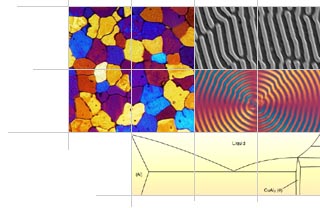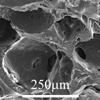Micrograph Library
Browse the libraryAdvanced searchSystemsCompositionsTechniquesKeywordsPhase diagramsHelpPreferencesAbout the micrograph libraryTerms of useContribute micrographs!FeedbackLinksCredits Print this page

Full Record for Micrograph 115

[125 KB]
View micrograph
.. in new window
View micrograph and record
.. in new window
You can also view and download the micrographs on Flickr
- Micrograph no
- 115
- Brief description
- Poly (lactic-co-glycolic acid) (PLGA) porous scaffold for tissue engineering. Average Pore Size 350-550 micrometre, porosity estimated at 35-45%
- Keywords
- biodegradable polymer
 , bone
, bone  , poly(lactide-co-glycolic acid) PLGA, polymer
, poly(lactide-co-glycolic acid) PLGA, polymer  , tissue engineering
, tissue engineering 
- Categories
- Polymer
- System
- Poly (lactic-co-glycolic acid) (PLGA)
- Composition
- Not specified
- Standard codes
- Reaction
- Processing
- PLGA melt cast, particulate leaching (NaCl)
- Applications
- Sample preparation
- Freeze fractured using liquid nitrogen, gold sputter coated
- Technique
- Scanning electron microscopy (SEM)
- Length bar
- 250 μm
- Further information
- The patients own cells are seeded onto the scaffold and allowed to attach and start producing new bone. The construct is implanted into the defect site, where eventually the polymer will biodegrade and be completely removed, leaving a natural autogenous bone graft. This technique is particularly useful for large defects, or where the host bed is compromised due to disease, although it is still at the research stage.
- Contributor
- V A Mellon
- Organisation
- Department of Materials Science and Metallurgy, University of Cambridge
- Date
- 03/12/01
- Licence for re-use
 Attribution-NonCommercial-ShareAlike 4.0 International
Attribution-NonCommercial-ShareAlike 4.0 International- Related micrographs
- Micrograph 114: Poly (lactic-co-glycolic acid) (PLGA) porous scaffold for tissue engineering. Average Pore Size 350-550 micrometre, porosity estimated at 35-45% (3 mm)
- Micrograph 116: Poly (lactic-co-glycolic acid) (PLGA) porous scaffold for tissue engineering. Enlargement of a Pore. Average Pore Size 350-550 mm, porosity estimated at 35-45% (250 μm)

